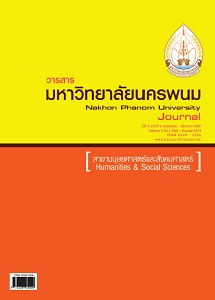การเปิดรับ และการตระหนักรู้ของประชาชนเกี่ยวกับการสื่อสารแจ้งข่าวเตือนภัยน้ำท่วม ในพื้นที่เสี่ยงภัยน้ำท่วม จังหวัดลพบุรี
Main Article Content
Abstract
การวิจัยครั้งนี้มีวัตถุประสงค์เพื่อ 1) ศึกษาการเปิดรับข่าวสารของประชาชนเกี่ยวกับการสื่อสารเตือนภัยในพื้นที่เสี่ยงภัยน้ำท่วม จังหวัดลพบุรี 2) ศึกษาการตระหนักรู้ของประชาชนเกี่ยวกับการสื่อสารเตือนภัยในพื้นที่เสี่ยงภัยน้ำท่วม จังหวัดลพบุรี 3) ศึกษาความ แตกต่างระหว่างลักษณะทางประชากรกับการเปิดรับข่าวสารและการตระหนักรู้ในการสื่อสารเตือนภัยในพื้นที่เสี่ยงภัยน้ำท่วมจังหวัด ลพบุรี และ 4) ศึกษาความสัมพันธ์ระหว่างการเปิดรับข่าวสารกับการตระหนักรู้ของประชาชนเกี่ยวกับการสื่อสารเตือนภัยในพื้นที่เสี่ยง ภัยน้ำท่วมจังหวัดลพบุรีการวิจัยครั้งนี้เป็นการวิจัยเชิงสำรวจ กลุ่มตัวอย่าง ได้แก่ ประชาชนในเขตพื้นที่ประสบภัยน้ำท่วม จังหวัดลพบุรี จำนวน 400 คน สุ่มตัวอย่างแบบหลายขั้นตอนเครื่องมือที่ใช้ในการวิจัยคือ แบบสอบถาม โดยมีค่าความเชื่อมั่นเท่ากับ 0.97 และ วิเคราะห์ข้อมูลโดยใช้สถิติความถี่ ร้อยละ ค่าเฉลี่ย ส่วนเบี่ยงเบนมาตรฐานใช้ทดสอบที (t-test) และการวิเคราะห์ความแปรปรวนทาง เดียว (One way ANOVA) และใช้ค่าสัมประสิทธิสหสัมพันธ์แบบเพียร์สันผลการวิจัยพบว่า 1) ประชาชนเปิดรับข่าวสารเตือนภัยน้ำท่วม จากสื่อโทรทัศน์/เคเบิ้ลทีวี มากที่สุด รองลงมาคือ หนังสือพิมพ์ สื่อบุคคล อินเทอร์เน็ต วิทยุ และหอกระจายข่าว/เสียงตามสาย สื่อสิ่งพิมพ์ และสื่ออื่นๆ ตามลำดับ 2) ประชาชนมีการตระหนักรู้ในการสื่อสารเตือนภัยน้ำท่วมด้านความรู้ความเข้าใจ ด้านอารมณ์และ ความรู้สึก และด้านพฤติกรรมในระดับมาก 3) ประชาชนที่มีเพศ อายุ การศึกษา และรายได้ แตกต่างกัน มีการเปิดรับข่าวสารจากสื่อใน การสื่อสารเตือนภัยน้ำท่วมแตกต่างกัน 4) ประชาชนที่มีการศึกษา อาชีพ และรายได้ที่แตกต่างกัน มีการตระหนักรู้ในการสื่อสารเตือน ภัยแตกต่างกัน 5) การเปิดรับข่าวสารเกี่ยวกับการสื่อสารเตือนภัยน้ำท่วมกับการตระหนักรู้มีความสัมพันธ์กันในเชิงบวก โดยเฉพาะ การเปิดรับข่าวสารจากสื่อหนังสือพิมพ์มีความสัมพันธ์กับการตระหนักรู้ทั้งสามด้าน คือ ด้านความรู้ความเข้าใจ ด้านอารมณ์และ ความรู้สึก และด้านพฤติกรรม
The objectives of this study were: 1) to investigate the exposure to flood warning messages of citizens in the flood-prone areas of Lopburi province, 2) to examine those citizens’ awareness of flood warning messages, 3) to investigate the exposure to flood warning messages and the awareness of them among citizens whose personal backgrounds were different, and 4) to examine the relationship between the citizens’ exposure to and their awareness of flood warning messages. The study was a survey research. The sample selected through multistage random sampling consisted of 400 residents of the areas that had flooded in Lopburi province. The instrument employed was a questionnaire whose reliability coefficient was 0.97. Data analysis was conducted using percentage, mean, standard deviation, t-test, one-way ANOVA and Pearson’s product moment correlation coefficient. The findings were as follows: 1) The citizens exposed themselves to flood warning messages mainly from the media of TV and cable TV, followed by the media of newspaper, person, the Internet, radio and broadcasting tower/ information via public loud-speakers, and the like respectively; 2) the citizens had awareness of flood warning messages in the aspects of knowledge and understanding, emotion and feeling, and behavior at high level; 3) the citizens whose sexes, ages, educational attainments, and incomes were different had a difference in their exposure to flood warning messages from the media; 4) the citizens whose educational attainments, occupations and incomes were different had a difference in their awareness of flood warning messages; 5) the exposure to flood warning messages and the awareness of them among the citizens were positively correlated. The exposure to messages from the newspaper medium in particular had relations with the awareness in all the 3 aspects : knowledge and understanding, emotion and feeling, and behavior.


